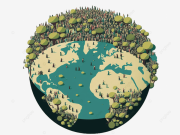Welcome to our blog, where we explore the topic of nuclear energy and its role in meeting the world’s growing energy needs. Join us as we delve into the science behind nuclear power, examine its benefits and challenges, and discuss its potential as a sustainable and low-carbon energy source. From understanding nuclear reactions to exploring safety measures and waste management, we’ll shed light on the complexities of nuclear energy and its place in the global energy landscape.
Understanding Nuclear Energy:
1.1 Nuclear Reactions and Power Generation:
Explaining the principles of nuclear fission and nuclear fusion as sources of energy.
Discussing the process of nuclear power generation in nuclear reactors.
1.2 Types of Nuclear Reactors:
Exploring different types of nuclear reactors, such as pressurized water reactors (PWR), boiling water reactors (BWR), and advanced reactor designs.
Discussing the advantages and disadvantages of each reactor type.
1.3 Nuclear Fuel Cycle:
Describing the stages of the nuclear fuel cycle, including uranium mining, enrichment, fuel fabrication, reactor operation, and spent fuel management.
Addressing the challenges and potential environmental impacts associated with the nuclear fuel cycle.
Benefits and Challenges of Nuclear Energy:
2.1 Low-Carbon Energy Source:
Highlighting the low greenhouse gas emissions associated with nuclear power generation.
Discussing the potential role of nuclear energy in mitigating climate change.
2.2 Energy Efficiency and High Power Density:
Exploring the high energy density and efficiency of nuclear power compared to other energy sources.
Discussing the potential for nuclear energy to meet growing energy demands.
2.3 Safety and Risk Management:
Addressing the safety measures implemented in nuclear power plants to prevent accidents and mitigate risks.
Discussing lessons learned from past nuclear incidents and the continuous improvement of safety standards.
2.4 Nuclear Waste Management:
Exploring the challenges and solutions for the management of radioactive waste.
Discussing the strategies for long-term storage, disposal, and potential recycling of nuclear waste.
Nuclear Energy and the Environment:
3.1 Air Pollution and Climate Change Mitigation:
Discussing the potential of nuclear energy to reduce air pollution and dependence on fossil fuels.
Addressing the role of nuclear power in achieving clean energy transition goals.
3.2 Water Consumption and Impact:
Examining the water requirements of nuclear power plants and their potential impact on local water resources.
Discussing strategies for minimizing water consumption and implementing sustainable water management practices.
3.3 Land Use and Ecological Considerations:
Addressing the land use requirements of nuclear power plants and associated facilities.
Discussing the potential impacts on ecosystems, biodiversity, and local communities.
Nuclear Energy and Society:
4.1 Energy Security and Reliability:
Exploring the role of nuclear energy in diversifying energy sources and enhancing energy security.
Discussing the reliability and baseload characteristics of nuclear power.
4.2 Economic Considerations:
Examining the costs associated with nuclear power plant construction, operation, and decommissioning.
Discussing the economic competitiveness of nuclear energy compared to other energy sources.
4.3 Public Perception and Education:
Addressing public concerns, misconceptions, and risk perceptions associated with nuclear energy.
Discussing the importance of public engagement, transparency, and education in fostering informed decision-making.
Future of Nuclear Energy:
5.1 Advanced Nuclear Technologies:
Exploring advanced reactor designs, such as small modular reactors (SMRs) and Generation IV reactors.
Discussing their potential benefits in terms of safety, efficiency, and waste reduction.
5.2 Nuclear Energy and Renewables Integration:
Addressing the potential synergies between nuclear energy and renewable energy sources.
Discussing the role of nuclear power as a complement to intermittent renewables in a balanced energy mix.
5.3 Policy and Regulatory Frameworks:
Examining the importance of stable policy and regulatory frameworks to support the development and deployment of nuclear energy.
Discussing international cooperation and collaboration in nuclear energy research and development.
Conclusion:
As we conclude our exploration of nuclear energy, we recognize the complex nature of this power source and its potential benefits and challenges. By understanding the science behind nuclear reactions, implementing robust safety measures, addressing waste management concerns, and fostering public engagement, we can work towards harnessing the power of the atom for a sustainable and reliable energy future.






















